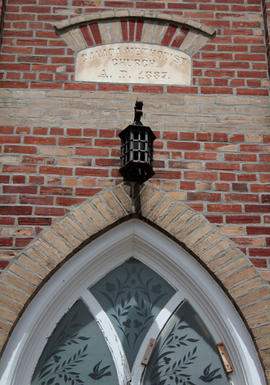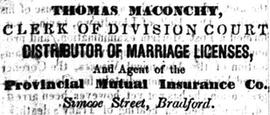Working to Preserve Convent's History
- CA BWGPL WEG-Arch-OS8412-PH25356
- Part
- 1987-03-08
Part of WEGWHIST Collection
Working to Preserve Convent's History
Bradford - A lot of people are interested in seeing the empty building known as the old convent on Barrie Street saved, says one Bradford resident who is determined to do his part.
Jim Culbert, known to those who have had him repair or finish furniture as The Furniture Doctor, has made the fate of the convent a personal concern.
His interest in the convent has resulted in several newspaper articles citing him as someone who knows a lot about the building's past, and every time one is published he gets calls of support from others, he says.
If, as is likely, a committee is struck to determine how the convent will be converted into a recreation complex, (as is recommended in the master recreation plan) Mr. Culbert says he wants to be on the committee.
"The entrance hall is large enough for a reception area," he said, in an interview at his Bradford home. "And the games room, living room and dining room could all be used without changing them."
Mr. Culbert's interest in the building isn't just as an observer. He has toured the building since it was left empty a few years ago when it was sold to the town by Fred Picavet.
The video tape he made of the building has been joined with a film of the April 1986 council meeting where council decided to end a long simmering court battle with Mr. Picavet and bought the convent for $125,000.
(The purchase was agreed to in conjunction with signing a subdivision approval for Mr. Picavet, a situation that Reeve Sandy Hudson said, "stinks," but it was approved on a vote of 4-2; Deputy-reeve Bill Dykie also voted against; councillor Gary Lamb was absent.)
Now, also on that tape, is last week's master recreation plan meeting. The subject of the convent was not discussed at the meeting, but the recommendations of the report include a suggestion that the convent be partly renovated and turned into a recreation complex.
Mr. Culbert said he plans to edit and complete the tape when the convent reaches its next evolution. Then, he will give one copy to the library, and one to the town, he said, in the hopes that the building's history can stay alive.
He is also working on a booklet on the convent's history, which now includes news clippings, letters and photographs.
He has tried to contact some of the former residents or their families, and has been somewhat successful. Although he could not get any information from the Ursuline Nuns who once resided in the building, he did contact the grandson of Samuel Lukes, owner of the building from 1910 to 1929, when it went to his son Gilbert.
Tom Lukes wrote from Wales about his memories as a young adult.
Mr. Culbert said he also received a phone call from the grandson of missionary Egerton Ryerson Young, who owned it from 1903 to 1910.
"He was quite indignant," Mr. Culbert said, about a news article that referred to the building as a grand old house, and home to the wealthy and prominent.
"His grandfather was not a rich person," Mr. Culbert said.
Although he objected to the view of the building as a mansion, he said he wanted to see it preserved, and told Mr. Culbert he would donate some money if fundraising were done.
Mr. Culbert said once he finishes his history of the convent, he would like to see it, or some other indication of the buildings history, in the entranceway of the building when it is reopened.
Chronology
(As compiled, in part, by Jim Culbert)
Aug. 2, 1871 - John MacLean Stevenson bought three acres of land on the east of Barrie Street, between Letitia and Moore Streets, from John and Eliza Armstrong, for $1,200.
June 29, 1876 - Mr. Stevenson, reeve from 1871-1877, borrowed $3,957.50 to start construction on plans he brought back from Scotland, for a castle with an Italianate flavor.
April 10, 1877 - the house was sold to Robert Bingham for $5,500. The family lived there for 16 years, until Robert's death. April 20, 1893 - Caroline Bingham sold the home to James and Emily Boddy for $2,000, the price lowered by the depression. James Boddy, Reeve from 1894-96, lived in "Fairview," until November 24, 1903, when it was sold under power of sale for $1,900 to Charlotte Jeffs, and quickly resold for $2,300 to Rev. Egerton Ryerson Young.
"Algonquin Lodge" was home to the world-famed reverend until his death in 1910.
April 10, 1910 - sold to Samuel Lukes by Rev. Young's widow Libbie Bingham, for $3,600.
Renovations including new verandahs, were made to 'Luxalean."
Feb. 26, 1929 Samuel's son Gilbert took over the home on his father's death and made alterations to the front and side, including additions of the sunroom. The outside was stuccoed for warmth.
June 1945, Nov. 1947, July 1949 - three parcels of land were severed from the property and sold to neighbours.
Oct. 26, 1949 - sold to the Roman Catholic Archdiocese of Toronto for $19,000, and again sold Dec. 10, 1950 to the Ursulina Order of the Diocese of London, a group of teaching nuns, for $14,000, which excluding the land to the south, where St. Mary's Catholic School was built.
July 4, 1969 - sold to John and Maria Moniz for $28,000. It was renovated to an apartment building (contrary to zoning bylaws).
Feb. 10, 1981 - The deed was acquired by Fred and Betty Lou Picavet, who began removing the stucco and interior plaster, with plans to renovate and live in the home.
Feb. 26, 1981 - Bradford Council brought a stop to work order and a certificate of Lis Pendents, and the ownership of the building went before the courts.
The building lay empty, and began deteriorating as each side said they were the rightful owners.
April 16, 1986 - Bradford Council signed an agreement to purchase the building for $125,000 from the Picavets.
The building has been boarded up since then, awaiting a decision on its fate. The master recreation plan, released in draft form March 10, 1987, suggests it be partially demolished, partially renovated to form part of a new recreation and leisure complex on the site.
Bradford Weekly






